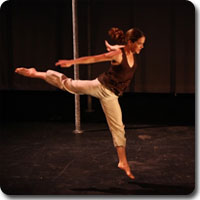 Lawrence-Herchenroether Dance Company, artists-in-residence at Girard College and Mascher Space Cooperative, is a Philadelphia-based modern dance company that produces the work of choreographer Tori Lawrence. By emphasizing the creative process, the Lawrence-Herchenroether Dance Company strives to create a shared experience between the performers and audience members. Continuously exploring the dynamic relationship among movement, perception, and environment, the company works towards creating choreography that is surprising, thoughtful, and honest. Co-founders Tori Lawrence and Emily Herchenroether stopped communing with their audiences long enough to answer a few of our questions about supporting the arts…
Lawrence-Herchenroether Dance Company, artists-in-residence at Girard College and Mascher Space Cooperative, is a Philadelphia-based modern dance company that produces the work of choreographer Tori Lawrence. By emphasizing the creative process, the Lawrence-Herchenroether Dance Company strives to create a shared experience between the performers and audience members. Continuously exploring the dynamic relationship among movement, perception, and environment, the company works towards creating choreography that is surprising, thoughtful, and honest. Co-founders Tori Lawrence and Emily Herchenroether stopped communing with their audiences long enough to answer a few of our questions about supporting the arts…
TILE: Why is it important to support the arts?
Tori & Emily: Art opens up conversations and new ways of looking at things. It encourages dialogue between the creator and the perceiver, helping to push and challenge us as individuals and as communities. It helps us progress as beings to more deeply relate to the world and the environment around us.
TILE: What’s it like to run your own show as an independent modern dance company?
Tori & Emily: We become intimately aware of all of the details that go into a live production that aren’t related to the art. Examples are marketing, fund-raising, grant writing, rehearsal/performance space rental, etc. You have to realize that you’re providing a full experience for the audience rather than solely the work or choreography itself.
There’s also a lot of problem solving and awareness of all of the expenses that go into forming a dance company. Finding a way to balance your needs and limited funds is hard and we’re still trying to figure it out. We have come to realize that we are business owners that have branded a company as well as artists that have branded a voice.
TILE: We hear a lot about how artists of all ages are struggling financially to bring their work to life. What kind of advice would you give to young people who want to help out by supporting the arts?
Tori & Emily: Our advice: Go to shows and experience art (whether they be concerts, gallery openings, dance performances, jams, etc.). Find someone whose work moves you or strikes you in a certain way. I would recommend concentrating your funds in that one person/company and one area rather than spreading it to a group of different artists/companies.
Deep investment is better than a broad investment in art because you make more of an impact and you can experience the effects of your donation more easily. Deep investment in one artist or one company encourages longevity and sustainability.
TILE: As young performing artists, what kind of role would you like to see your own art and that of others playing in the future?
Tori & Emily: Bringing the audience to be more engaged in our art (a mind/body/soul engagement). In our site-specific dance performances, we prod, poke, and allow those deep/inner questions to surface. Hopefully the worlds that we create can inspire our audience members to become more engaged with their surroundings.
TILE: We can all learn from each other, so… what’s the biggest financial mistake you’ve ever made?
Tori & Emily: We rented a space inside an outmoded power plant for one of our shows at the Philly Fringe last year. Our performance involved a lot of water. At the end of the performance, we didn’t have the appropriate resources to clean up the water and dirt that we left behind, so we ended up being penalized for not thoroughly cleaning the space.
What we learned: Be aware of the risks that you take when you put down a deposit for a performance venue.
Be clear ahead of time what’s expected of you to get the deposit back so that you can do what’s expected and not lose money unnecessarily.
>> TILE brings you exclusive opinions, explanations, and interviews from experts in every industry. To read more, click on Ask the Experts in the TILE Library.
Have a burning question or an expert you’d like to see interviewed? Just Ask TILE!
![]()

 Pamela Vail is a performer, choreographer, improviser and teacher. She is an Assistant Professor of Dance at Franklin & Marshall College, and also performs with several professional dance companies and creates her own choreography. To sample some of her work, visit
Pamela Vail is a performer, choreographer, improviser and teacher. She is an Assistant Professor of Dance at Franklin & Marshall College, and also performs with several professional dance companies and creates her own choreography. To sample some of her work, visit